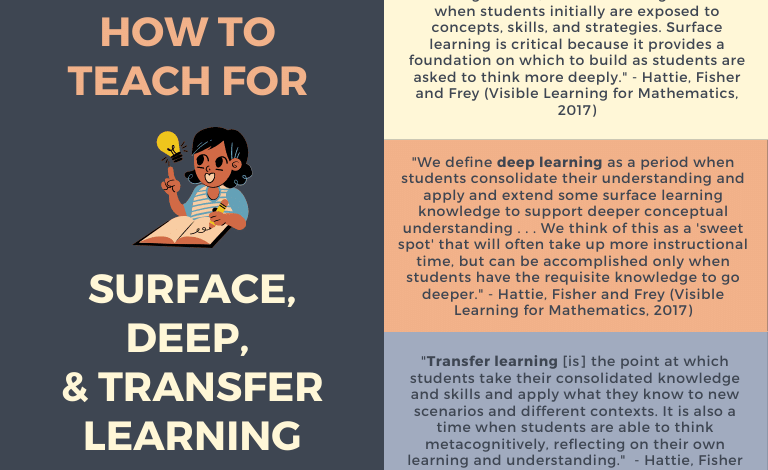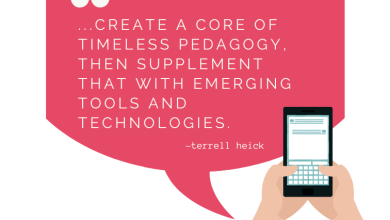The Definition Of 5 Different Types Of Teaching –


How To Teach For Surface, Deep, and Transfer Learning
by TeachThought Staff
John Hattie is an influential education researcher well known for his study of the effectiveness of teaching methods and strategies.
While there are other educational researchers and thought leaders who have explored these topics, Hattie’s views on surface, transfer, and deeper learning and the role of direct and explicit instruction and inquiry teaching in facilitating them can be helpful for educators as they plan and deliver instruction. His extensive research work over decades coupled with a nuanced and reflective approach makes him a valuable source for teachers looking to prepare students for the modern world.
What Is Surface Learning?
Definition Of Deep Learning: Hattie considers surface learning to be the foundation for deeper learning. Surface learning involves the acquisition of basic knowledge and skills, often through repetition and memorization. However, Hattie argues that surface learning alone is not sufficient for success in school or life. Rather, surface learning should be the starting point for deeper learning, which involves critical thinking and problem-solving skills.
“Surface learning does not mean superficial learning. Rather, surface learning is a time when students initially are exposed to concepts, skills, and strategies. Surface learning is critical because it provides a foundation on which to build as students are asked to think more deeply.”
– Hattie, Fisher and Frey (Visible Learning for Mathematics, 2017)
See also 6 Questions About Hatties Meta Analyses
What Is Deep Learning?
Definition Of Deep Learning: Deep (or deeper) learning is a complex process that involves the development of critical thinking and problem-solving skills. Hattie argues that deeper learning is facilitated through inquiry teaching, which involves asking questions, exploring concepts, and engaging in meaningful discussions. Inquiry teaching allows students to develop their own understanding of concepts and to connect new knowledge to their existing knowledge. Hattie suggests that inquiry teaching is particularly effective when it is combined with direct and explicit instruction, which provides students with the basic knowledge and skills they need to engage in deeper learning.
“We define deep learning as a period when students consolidate their understanding and apply and extend some surface learning knowledge to support deeper conceptual understanding . . . We think of this as a ‘sweet spot’ that will often take up more instructional time, but can be accomplished only when students have the requisite knowledge to go deeper.”
– Hattie, Fisher and Frey (Visible Learning for Mathematics, 2017)
What Is Transfer Learning?
Definition Of Transfer Learning: Hattie argues that transfer learning is crucial for success in the real world. Transfer learning involves the ability to apply knowledge and skills learned in one context to new situations. Hattie suggests that transfer learning is facilitated when students are taught explicitly and directly. This means that teachers should explicitly teach students how to transfer their knowledge and skills to new contexts, rather than assuming that they will do so automatically.
See also Types Of Transfer Of Learning
“Transfer learning [is] the point at which students take their consolidated knowledge and skills and apply what they know to new scenarios and different contexts. It is also a time when students are able to think metacognitively, reflecting on their own learning and understanding.”
– Hattie, Fisher and Frey (Visible Learning for Mathematics, 2017)
What Is Direct and Explicit Instruction?
Direct and explicit instruction involves the teacher clearly explaining concepts, modeling strategies, and providing immediate feedback to students. Hattie suggests that direct and explicit instruction is particularly effective for surface learning and for facilitating transfer learning. When teachers provide clear and explicit instruction, students are more likely to retain information and transfer their knowledge to new contexts.
What Is Inquiry Teaching?
Definition Of Inquiry Learning: Inquiry teaching involves a more student-centered approach, where students are encouraged to explore concepts, ask questions, and engage in meaningful discussions. Hattie suggests that inquiry teaching is particularly effective for facilitating deeper learning, as it allows students to connect new knowledge to their existing knowledge and develop their own understanding of concepts.
While some will cite the low effect size of inquiry teaching in advocacy for explicit and direct instruction it is important to note that Hattie suggests that inquiry can become a powerful deep learning and/or transfer learning strategy when paired with and including methods that build significant surface learning. As we’ve noted previously, the 5 phases of robust project-based learning include this combination, and PBL is a great tool to build surface, deep, and transfer learning when done well.
“However, when students have appropriate surface knowledge, problem-based learning has been shown to be very effective in consolidating and developing deeper understandings. – Hattie (Visible Learning: The Sequel, 2023)
John Hattie’s body of work suggests that surface learning is the foundation for deeper learning, transfer learning is crucial for success in the real world, and deeper learning is facilitated through inquiry teaching. Hattie argues that direct and explicit instruction is particularly effective for surface learning and for facilitating transfer learning, while inquiry teaching is particularly effective for facilitating deeper learning.
By understanding these different types of learning and the role of teaching in facilitating them, educators can develop more effective teaching strategies and better prepare students for the modern world.




